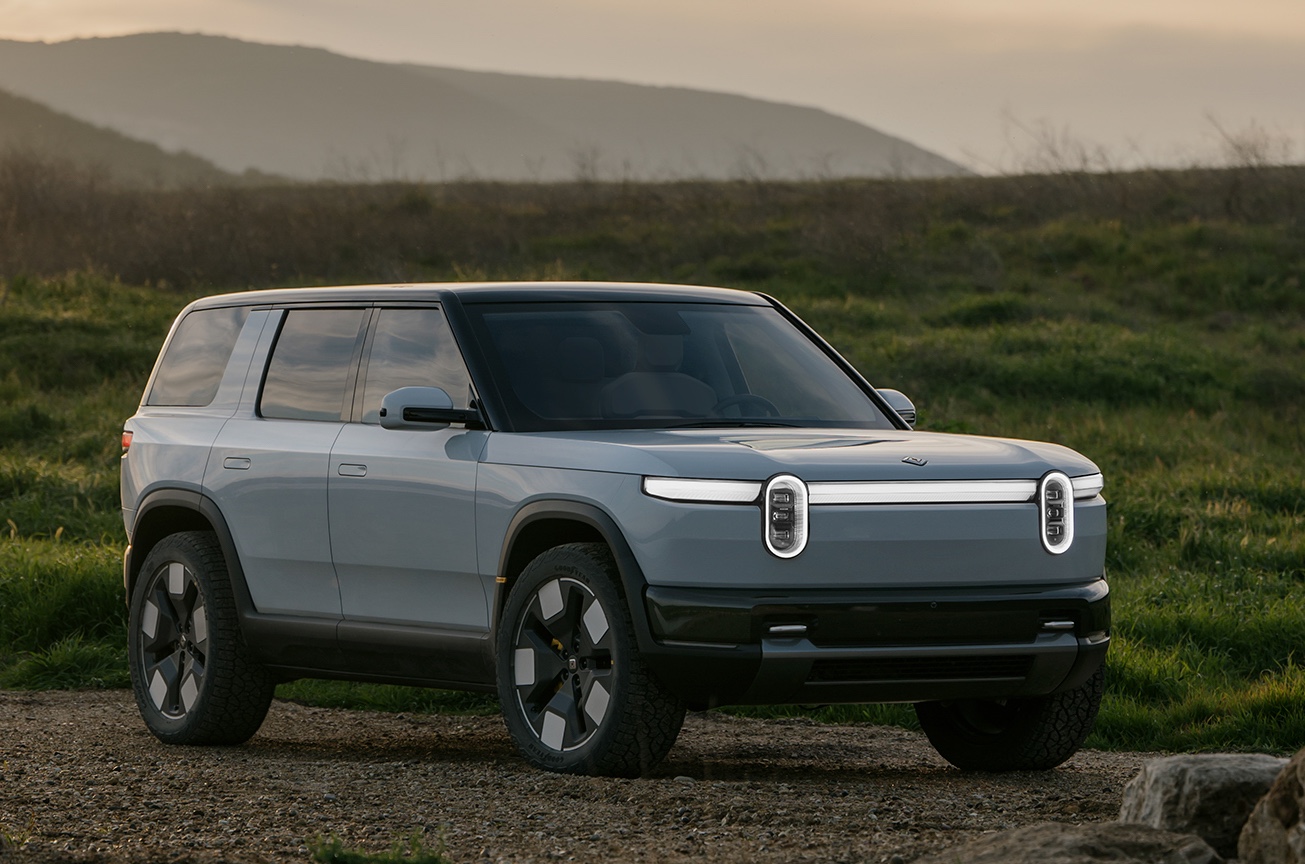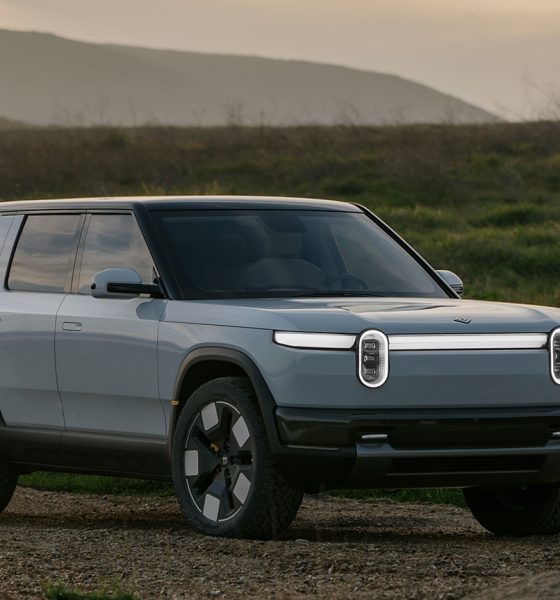Rivian has announced plans to take its upcoming electric vehicles (EVs) on a tour around North America, after the company unveiled the R2 and R3 models earlier this year.
Last week, Rivian announced in a post on its website that it would be displaying both the upcoming R2 and R3X vehicles at various locations in the U.S. and Canada, after initially launching displays at a few select stores. All of the events are set to include the R2 and R3X except the LA Auto Show, which won’t include the R3X, and most of the tour is taking place at automotive shows.
“Get ready—our R2 Road Tour is coming to a town near you,” Rivian writes. “We’re cruising through cities across the country, bringing you an up close and personal look at the all-new R2. You can also meet the new Gen 2 R1S & R1T and take a demo drive. Keep an eye out for R3X making guest appearances along the way.”
The news also comes after Rivian officially began expanding its Normal, Illinois factory last week to accommodate production of the R2 pickup and SUV. The company was originally approved for such an expansion in August, after a unanimous vote from Normal Town Council.
According to Rivian’s VP of Manufacturing Tim Fallon in a statement in July, the R2 had already gained more than 100,000 pre-orders, following its unveiling in March. In a surprise move after the R2 was unveiled, Rivian went on to share an additional EV, the R3X, is expected to enter production after the R2.
In addition to the upcoming R2 and R3X displays, Rivian has had the R2 on display at multiple locations in California, as well as in Vancouver, B.C., Portland, New York City, Nashville, Austin, and Boston. You can see all of Rivian’s upcoming R2 and R3X appearances below, including an ongoing display at the company’s Laguna Beach space that ends on Sunday.
Rivian R2 and R3X appearances in 2024
November 15 to 17: Laguna Beach (10:00 am – 6:00 pm)
Rivian South Coast Theater – 162 S Coast Hwy, Laguna Beach, CA 92651
November 20: Venice (11:00 am – 7:00 pm)
Rivian Venice Space – 660 Venice Blvd., Venice, CA 90291
November 22 to 27 and November 30 to December 1: Los Angeles Auto Show
Los Angeles Convention Center – 1201 S Figueroa St, Los Angeles, CA 90015
- 11/22 to 11/24: 9:00 a.m. – 5:00 p.m.
- 11/25 to 11/27: 11:00 a.m. – 5:00 p.m.
- 11/28 to 11/29: No viewings of R2 and R3X for holiday
- 11/30: 9:00 a.m. – 5:00 p.m.
- 12/1: 9:00 a.m. – 5:00 p.m.
Note: The Rivian R3X will not be displayed at the LA Auto Show.
Rivian R2 and R3X appearances in 2025
January 11 to 20: Detroit Auto Show
Huntington Place: 1 Washington Blvd., Detroit, MI 48226
- 1/11 to 1/14: 10:00 a.m. – 8:00 p.m.
- 1/15 to 1/16: 1:00pm – 8:00 p.m.
- 1/17 to 1/19: 10:00 a.m. – 8:00 p.m.
- 1/20: 10:00 a.m. – 7:00 p.m.
February 8 to 17: Chicago Auto Show
McCormick Place: 2301 S Martin Luther King Dr, Chicago, IL 60616
- 2/8: 10:00 a.m. – 9:00 p.m.
- 2/9: 10:00 a.m. – 6:00 p.m.
- 2/10 to 2/16: 10:00 a.m. – 9:00 p.m.
- 2/17: 10:00 a.m. – 8:00 p.m.
February 19 to 23: Toronto (Canadian International Auto Show)
Metro Toronto Convention Centre: 255 Front St W, Toronto, ON M5V 2W6, Canada
- Time: TBD
March 19 to 23: Vancouver Auto Show
Vancouver Convention Centre: 1055 Canada Place, Vancouver, B.C.
- 3/19: 12:00 p.m. – 9:00 p.m.
- 3/20 to 3/22: 10:00 a.m. – 9:00 p.m.
- 3/23: 10:00 a.m. – 6:00 p.m.
What are your thoughts? Let me know at zach@teslarati.com, find me on X at @zacharyvisconti, or send us tips at tips@teslarati.com.
Rivian and Volkswagen expand joint venture in hopes of surviving EV transition

News
Tesla starts showing how FSD will change lives in Europe
Local officials tested the system on narrow country roads and were impressed by FSD’s smooth, human-like driving, with some calling the service a game-changer for everyday life in areas that are far from urban centers.

Tesla has launched Europe’s first public shuttle service using Full Self-Driving (Supervised) in the rural Eifelkreis Bitburg-Prüm region of Germany, demonstrating how the technology can restore independence and mobility for people who struggle with limited transport options.
Local officials tested the system on narrow country roads and were impressed by FSD’s smooth, human-like driving, with some calling the service a game-changer for everyday life in areas that are far from urban centers.
Officials see real impact on rural residents
Arzfeld Mayor Johannes Kuhl and District Administrator Andreas Kruppert personally tested the Tesla shuttle service. This allowed them to see just how well FSD navigated winding lanes and rural roads confidently. Kruppert said, “Autonomous driving sounds like science fiction to many, but we simply see here that it works totally well in rural regions too.” Kuhl, for his part, also noted that FSD “feels like a very experienced driver.”
The pilot complements the area’s “Citizen Bus” program, which provides on-demand rides for elderly residents who can no longer drive themselves. Tesla Europe shared a video of a demonstration of the service, highlighting how FSD gives people their freedom back, even in places where public transport is not as prevalent.
What the Ministry for Economic Affairs and Transport says
Rhineland-Palatinate’s Minister Daniela Schmitt supported the project, praising the collaboration that made this “first of its kind in Europe” possible. As per the ministry, the rural rollout for the service shows FSD’s potential beyond major cities, and it delivers tangible benefits like grocery runs, doctor visits, and social connections for isolated residents.
“Reliable and flexible mobility is especially vital in rural areas. With the launch of a shuttle service using self-driving vehicles (FSD supervised) by Tesla in the Eifelkreis Bitburg-Prüm, an innovative pilot project is now getting underway that complements local community bus services. It is the first project of its kind in Europe.
“The result is a real gain for rural mobility: greater accessibility, more flexibility and tangible benefits for everyday life. A strong signal for innovation, cooperation and future-oriented mobility beyond urban centers,” the ministry wrote in a LinkedIn post.
News
Tesla China quietly posts Robotaxi-related job listing
Tesla China is currently seeking a Low Voltage Electrical Engineer to work on circuit board design for the company’s autonomous vehicles.

Tesla has posted a new job listing in Shanghai explicitly tied to its Robotaxi program, fueling speculation that the company is preparing to launch its dedicated autonomous ride-hailing service in China.
As noted in the listing, Tesla China is currently seeking a Low Voltage Electrical Engineer to work on circuit board design for the company’s autonomous vehicles.
Robotaxi-specific role
The listing, which was shared on social media platform X by industry watcher @tslaming, suggested that Tesla China is looking to fill the role urgently. The job listing itself specifically mentions that the person hired for the role will be working on the Low Voltage Hardware team, which would design the circuit boards that would serve as the nervous system of the Robotaxi.
Key tasks for the role, as indicated in the job listing, include collaboration with PCB layout, firmware, mechanical, program management, and validation teams, among other responsibilities. The role is based in Shanghai.
China Robotaxi launch
China represents a massive potential market for robotaxis, with its dense urban centers and supportive policies in select cities. Tesla has limited permission to roll out FSD in the country, though despite this, its vehicles have been hailed as among the best in the market when it comes to autonomous features. So far, at least, it appears that China supports Tesla’s FSD and Robotaxi rollout.
This was hinted at in November, when Tesla brought the Cybercab to the 8th China International Import Expo (CIIE) in Shanghai, marking the first time that the autonomous two-seater was brought to the Asia-Pacific region. The vehicle, despite not having a release date in China, received a significant amount of interest among the event’s attendees.
Elon Musk
Elon Musk and Tesla AI Director share insights after empty driver seat Robotaxi rides
The executives’ unoccupied tests hint at the rapid progress of Tesla’s unsupervised Robotaxi efforts.

Tesla CEO Elon Musk and AI Director Ashok Elluswamy celebrated Christmas Eve by sharing personal experiences with Robotaxi vehicles that had no safety monitor or occupant in the driver’s seat. Musk described the system’s “perfect driving” around Austin, while Elluswamy posted video from the back seat, calling it “an amazing experience.”
The executives’ unoccupied tests hint at the rapid progress of Tesla’s unsupervised Robotaxi efforts.
Elon and Ashok’s firsthand Robotaxi insights
Prior to Musk and the Tesla AI Director’s posts, sightings of unmanned Teslas navigating public roads were widely shared on social media. One such vehicle was spotted in Austin, Texas, which Elon Musk acknowleged by stating that “Testing is underway with no occupants in the car.”
Based on his Christmas Eve post, Musk seemed to have tested an unmanned Tesla himself. “A Tesla with no safety monitor in the car and me sitting in the passenger seat took me all around Austin on Sunday with perfect driving,” Musk wrote in his post.
Elluswamy responded with a 2-minute video showing himself in the rear of an unmanned Tesla. The video featured the vehicle’s empty front seats, as well as its smooth handling through real-world traffic. He captioned his video with the words, “It’s an amazing experience!”
Towards Unsupervised operations
During an xAI Hackathon earlier this month, Elon Musk mentioned that Tesla owed be removing Safety Monitors from its Robotaxis in Austin in just three weeks. “Unsupervised is pretty much solved at this point. So there will be Tesla Robotaxis operating in Austin with no one in them. Not even anyone in the passenger seat in about three weeks,” he said. Musk echoed similar estimates at the 2025 Annual Shareholder Meeting and the Q3 2025 earnings call.
Considering the insights that were posted Musk and Elluswamy, it does appear that Tesla is working hard towards operating its Robotaxis with no safety monitors. This is quite impressive considering that the service was launched just earlier this year.










